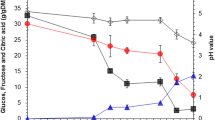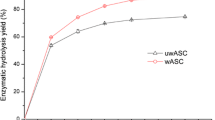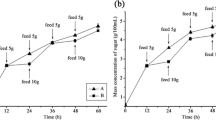Abstract
The prehydrolyzate obtained from acid-catalyzed steam-exploded corn stover (ASC) mainly contains xylose and a number of inhibitory compounds that inhibit ethanol fermentation by Pichia stipitis. In this study, the effects of the ASC prehydrolyzate, specifically those of the carbohydrate-degradation products, lignin-degradation products (which were extracted from ASC prehydrolyzate using ethyl acetate), and six major phenolic compounds (added to pure-sugar media individually or in combination), on ethanol fermentation were investigated. Results indicate that the effects of the carbohydrate-degradation products were negligible (10 h delayed) compared with those of pure-sugar fermentation, whereas the effects of the lignin-degradation products were significant (52 h delayed). Meanwhile, the inhibitory effects of the major phenolic compounds were not caused by certain types of inhibitors, but were due to the synergistic effects of various inhibitors.




Similar content being viewed by others
References
Talebnia F, Karakashev D, Angelidaki I (2010) Production of bioethanol from wheat straw: an overview on pretreatment, hydrolysis and fermentation. Bioresour Technol 101:4744–4753
Mood SH, Golfeshan AH, Tabatabaei M, Jouzani GS, Najafi GH, Gholami M, Ardjmand M (2013) Lignocellulosic biomass to bioethanol, a comprehensive review with a focus on pretreatment. Renew Sustain Energy Rev 27:77–93
Chiaramonti D, Prussi M, Ferrero S, Oriani L, Ottonello P, Torre P, Cherchi F (2012) Review of pretreatment processes for lignocellulosic ethanol production, and development of an innovative method. Biomass Bioenergy 46:25–35
Huang H, Guo X, Li D, Liu M, Wu J, Ren H (2011) Identification of crucial yeast inhibitors in bio-ethanol and improvement of fermentation at high pH and high total solids. Bioresour Technol 102:7486–7493
Ximenes E, Kim Y, Mosier N, Dien B, Ladisch M (2010) Inhibition of cellulases by phenols. Enzyme Microb Technol 46:170–176
Ximenes E, Kim Y, Mosier N, Dien B, Ladisch M (2011) Deactivation of cellulases by phenols. Enzyme Microb Technol 48:54–60
Kim Y, Ximenes E, Mosier NS, Ladisch MR (2011) Soluble inhibitors/deactivators of cellulase enzymes from lignocellulosic biomass. Enzyme Microb Technol 48:408–415
Zhu J, Yong Q, Xu Y, Yu S (2011) Detoxification of corn stover prehydrolyzate by trialkylamine extraction to improve the ethanol production with Pichia stipitis CBS 5776. Bioresour Technol 102:1663–1668
Palmqvist E, Hahn-Hägerdal B (2000) Fermentation of lignocellulosic hydrolysates. I: inhibition and detoxification. Bioresour Technol 74:17–24
Palmqvist E, Hahn-hägerdal B (2000) Fermentation of lignocellulosic hydrolysates. II: inhibitors and mechanisms of inhibition. Bioresour Technol 74:25–33
Jönsson LJ, Alriksson B, Nilvebrant NO (2013) Bioconversion of lignocelluloses: inhibitors and detoxification. Biotechnol Biofuels 6:16
Delgenes JP, Moletta R, Navarro JM (1996) Effects of lignocellulose degradation products on ethanol fermentations of glucose and xylose by Saccharomyces cerevisiae, Zymomonas mobilis, Pichia stipitis, and Candida shehatae. Enzyme Microb Technol 19:220–225
Zaldivar J, Ingram LO (1999) Effect of organic acids on the growth and fermentation of ethanologenic Escherichia coli LY01. Biotechnol Bioeng 66:203–210
Zaldivar J, Martinez A, Ingram LO (1999) Effect of selected aldehydes on the growth and fermentation of ethanologenic Escherichia coli. Biotechnol Bioeng 65:24–33
Zaldivar J, Martinez A, Ingram LO (1999) Effect of alcohol compounds found in hemicelluloses hydrolysate on the growth and fermentation of ethanologenic Escherichia coli. Biotechnol Bioeng 68:524–530
Chu Q, Li X, Ma B, Xu Y, Ouyang J, Zhu J, Yu S, Yong Q (2012) Bioethanol production: an integrated process of low substrate loading hydrolysis-high sugars liquid fermentation and solid state fermentation of enzymatic hydrolysis residue. Bioresour Technol 123:699–702
Buaban B, Inoue H, Yano S, Tanapongpipat S, Ruanglek V, Champreda V, Pichyangkura R, Rengpipat S, Eurwilaichitr L (2010) Bioethanol production from ball milled bagasse using an on-site produced fungal enzyme cocktail and xylose-fermenting Pichia stipitis. J Biosci Bioeng 110:18–25
Wilson JJ, Deschatelets L, Nishikawa NK (1989) Comparative fermentability of enzymatic and acid hydrolysates of steam-pretreated aspenwood hemicellulose by Pichia stipitis CBS 5776. Appl Microbiol Biotechnol 31:592–596
Zhu J, Zhu Y, Jiang F, Xu Y, Ouyang J, Yu S (2013) An integrated process to produce ethanol, vanillin, and xylooligosaccharides from Camellia oleifera shell. Carbohydr Res 382:52–57
Jiang Z, Zhu J, Li X, Lian Z, Yu S, Yong Q (2011) Determination of main degradation products of lignin using reversed-phase high performance liquid chromatography. Chin J Chromatogr 29:59–62
Nigam JN (2001) Ethanol production from wheat straw hemicelluloses hydrolysate by Pichia stipitis. J Biotechnol 87:17–27
Nishikawa NK, Sutcliffe R, Saddler JN (1988) The influence of lignin degradation products on xylose fermentation by Klebsiella pneumoniae. Appl Microbiol Biotechnol 27:549–552
Acknowledgments
The authors acknowledge the financial support from the National Natural Science Foundation of China (Grant No. 31100432), Research Fund for the Doctoral Program of Higher Education of China (Grant No. 20113204120013), Governmental Public Industry Research Special Funds for Projects (Grant No. 201004001), National Hi-Tech Research and Development Program of China (Grant No. 2012AA022304), Natural Science Foundation of Jiangsu Province of China (Grant No. BK2011819), and A Project Funded by the Priority Academic Program Development of Jiangsu Higher Education Institutions (PAPD).
Author information
Authors and Affiliations
Corresponding author
Rights and permissions
About this article
Cite this article
Zhu, J., Yang, J., Zhu, Y. et al. Cause analysis of the effects of acid-catalyzed steam-exploded corn stover prehydrolyzate on ethanol fermentation by Pichia stipitis CBS 5776. Bioprocess Biosyst Eng 37, 2215–2222 (2014). https://doi.org/10.1007/s00449-014-1199-0
Received:
Accepted:
Published:
Issue Date:
DOI: https://doi.org/10.1007/s00449-014-1199-0




